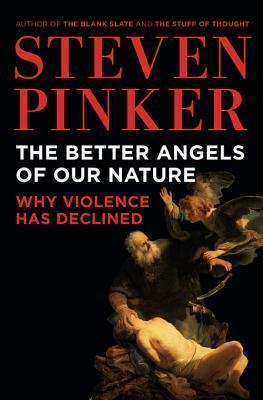More on this book
Community
Kindle Notes & Highlights
Read between
January 1 - January 1, 2020
The Better Angels of Our Nature is a tale of six trends, five inner demons, four better angels, and five historical forces.
Pacification Process.
Civilizing Process.
Humanitarian Revolution.
the Long Peace.
the New Peace.
the Rights Revolutions.
Predatory or instrumental violence
Dominance
Revenge
Sadism
ide...
This highlight has been truncated due to consecutive passage length restrictions.
Empathy
Self-control
moral sense
the faculty of reason allows us to extricate ourselves from our parochial vantage points, to reflect on the ways in which we live our lives, to deduce ways in which we could
be better off, and to guide the application of the other better angels of our nature.
Leviathan,
Commerce
Feminization
cosmopolitanism
the escalator of reason—can
As one becomes aware of the decline of violence, the world begins to look different. The past seems less innocent; the present less sinister. One starts to appreciate the small gifts of coexistence that would have seemed utopian to our ancestors:
With the knowledge that something has driven it down, we can also treat it as a matter of cause and effect. Instead of asking, “Why is there war?” we might ask, “Why is there peace?”
If the past is a foreign country, it is a shockingly violent one. It is easy to forget how dangerous life used to be, how deeply brutality was once woven into the fabric of daily existence. Cultural memory pacifies the past, leaving us with pale souvenirs whose bloody origins have been bleached away. A woman donning a cross seldom reflects that this instrument of torture was a common punishment in the ancient world;
Ötzi the Iceman,
Kennewick Man
Lindow Man,
Homer’s Iliad and Odyssey
Rather than framing the scourge of warfare as a human problem for humans to solve, they concocted a fantasy of hotheaded gods and attributed their own tragedies to the gods’ jealousies and follies.
Yet for all this reverence, the Bible is one long celebration of violence.
Cain rose up against Abel his brother, and slew him. With a world population of exactly four, that works out to a homicide rate of 25 percent, which is about a thousand times higher than the equivalent rates in Western countries today.
God instructs Noah in its moral lesson, namely the code of vendetta: “Whoso sheddeth man’s blood, by man shall his blood be shed.”
Abraham has a nephew, Lot, who settles in Sodom. Because the residents engage in anal sex and comparable sins, God immolates every man, woman, and child in a divine napalm attack. Lot’s wife, for the crime of turning around to look at the inferno, is put to death as well.
Abraham undergoes a test of his moral values when God orders him to take his son Isaac to a mountaintop,
obedience to divine authority, not reverence for human life, was the cardinal virtue.
When Jacob worries that neighboring tribes may attack them in revenge, his sons explain that it was worth the risk: “Should our sister be treated like a whore?”13 Soon afterward they reiterate their commitment to family values by selling their brother Joseph into slavery.
the Ten Commandments, the great moral code that outlaws engraved images and the coveting of livestock but gives a pass to slavery, rape, torture, mutilation, and genocide of neighboring tribes.
Joshua puts this directive into practice when he invades Canaan and sacks the city of Jericho.
Samson,
Saul,
David,
Solomon
The Bible depicts a world that, seen through modern eyes, is staggering in its savagery. People enslave, rape, and murder members of their immediate families. Warlords slaughter civilians indiscriminately, including the children. Women are bought, sold, and plundered like sex toys. And Yahweh tortures and massacres people by the hundreds of thousands for trivial disobedience or for no reason at all. These atrocities are neither isolated nor obscure. They implicate all the major characters of the Old Testament, the ones that Sunday-school children draw with crayons. And they fall into a
...more
The good news, of course, is that most of it never happened.
if there was a Davidic empire stretching from the Euphrates to the Red Sea around the turn of the 1st
millennium BCE, no one else at the time seemed to have noticed it.
Whether or not the Israelites actually engaged in genocide, they certainly thought it was a good idea. The possibility that a woman had a legitimate interest in not being raped or acquired as sexual property did not seem to register in anyone’s mind. The writers of the Bible saw nothing wrong with slavery or with cruel punishments like blinding, stoning, and hacking someone to pieces. Human life held no value in comparison with unthinking obedience to custom and authority.
Sensibilities toward violence have changed so much that religious people today compartmentalize their attitude to the Bible. They pay it lip service as a symbol of morality, while getting their actual morality from more modern principles.
The outrage that the story was meant to arouse was not that petty crimes were punishable by crucifixion but that Jesus was treated like a petty criminal.


